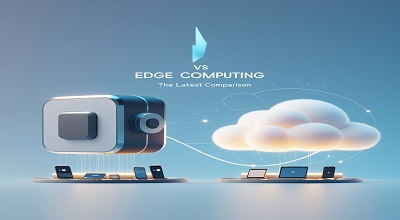Edge Computing vs Cloud Computing
Edge Computing vs Cloud Computing: In today’s fast-paced digital world, businesses and individuals rely heavily on data processing and storage solutions. Two of the most prominent technologies in this space are edge computing and cloud computing. While both play crucial roles in modern IT infrastructure, they serve different purposes.
This comprehensive guide will explore the latest trends, differences, benefits, and use cases of edge computing and cloud computing. By the end, you’ll understand which solution (or combination) is best for your needs.
What is Cloud Computing?
Cloud computing refers to the delivery of computing services—including storage, processing, networking, and software—over the internet. Instead of relying on local servers, businesses use remote data centers managed by third-party providers like AWS, Microsoft Azure, and Google Cloud.
Key Features of Cloud Computing
- Scalability: Easily expand or reduce resources based on demand.
- Cost-Efficiency: Pay-as-you-go models reduce upfront infrastructure costs.
- Remote Accessibility: Access data and applications from anywhere.
- Centralized Management: All data is stored and processed in large data centers.
Types of Cloud Computing Services
- Infrastructure as a Service (IaaS) – Virtualized computing resources (e.g., AWS EC2).
- Platform as a Service (PaaS) – Development platforms (e.g., Google App Engine).
- Software as a Service (SaaS) – Ready-to-use applications (e.g., Zoom, Salesforce).
What is Edge Computing?
Edge computing brings computation and data storage closer to the source of data generation (e.g., IoT devices, sensors, or local servers). Instead of sending all data to the cloud, processing happens at the “edge” of the network.
Key Features of Edge Computing
- Low Latency: Faster processing since data doesn’t travel long distances.
- Bandwidth Efficiency: Reduces the amount of data sent to the cloud.
- Real-Time Processing: Critical for applications like autonomous vehicles and industrial automation.
- Enhanced Security: Less exposure to centralized data breaches.
Common Edge Computing Use Cases
- Smart Cities – Traffic management, surveillance.
- Healthcare – Remote patient monitoring.
- Manufacturing – Predictive maintenance.
- Retail – Personalized customer experiences.
Edge Computing vs Cloud Computing: Key Differences
| Feature | Edge Computing | Cloud Computing |
|---|---|---|
| Data Processing | Local (near the source) | Centralized (remote data centers) |
| Latency | Very low | Higher (depends on internet speed) |
| Bandwidth Usage | Minimal | High |
| Scalability | Limited by local hardware | Highly scalable |
| Cost | Higher initial setup | Lower operational costs |
| Security | Reduced attack surface | Requires strong encryption |
Latest Trends in Edge and Cloud Computing (2025-2026)
1. Hybrid Cloud-Edge Solutions
Many businesses now adopt hybrid models, combining cloud scalability with edge efficiency. For example:
- Cloud for storage & analytics.
- Edge for real-time decision-making.
2. AI and Machine Learning at the Edge
AI-powered edge devices (like smart cameras) can process data locally without cloud dependency, improving speed and privacy.
3. 5G Enhancing Edge Computing
With faster 5G networks, edge computing will become even more powerful, enabling real-time applications like AR/VR and autonomous driving.
4. Sustainability in Cloud Computing
Cloud providers are focusing on green data centers to reduce carbon footprints.
5. Edge Security Advancements
New encryption and zero-trust models are making edge computing more secure.
When to Use Edge Computing vs Cloud Computing?
Best for Edge Computing:
✅ Real-time processing (e.g., autonomous vehicles).
✅ Limited internet connectivity (remote locations).
✅ High data privacy requirements (e.g., healthcare).
Best for Cloud Computing:
✅ Big data analytics & storage.
✅ Applications needing global access (e.g., SaaS platforms).
✅ Cost-effective scaling for startups.
Future of Edge and Cloud Computing
The future lies in convergence, not competition. Businesses will increasingly use:
- Edge for speed and efficiency.
- Cloud for storage and AI-driven insights.
Technologies like quantum computing and advanced IoT networks will further revolutionize both fields.
FAQs
1. Can edge computing replace cloud computing?
No, they complement each other. Edge computing handles real-time tasks, while the cloud manages large-scale storage and analytics.
2. Is edge computing more secure than cloud computing?
It depends. Edge reduces centralization risks, but cloud providers invest heavily in security. A hybrid approach is often best.
3. Which is cheaper: edge or cloud computing?
Cloud computing has lower initial costs, but edge can save bandwidth expenses in the long run.
4. How does 5G impact edge computing?
5G enables faster data transfer, making edge computing more efficient for IoT and real-time applications.
5. What industries benefit most from edge computing?
Healthcare, manufacturing, autonomous vehicles, and smart cities gain the most from edge computing.
Conclusion
Both edge computing and cloud computing are essential in today’s tech landscape. While cloud offers scalability and cost-efficiency, edge provides speed and reliability for real-time applications.
For businesses, the best approach is often a hybrid model, leveraging the strengths of both technologies. Stay updated with the latest trends to make informed decisions for your IT infrastructure.

